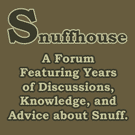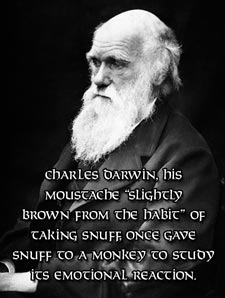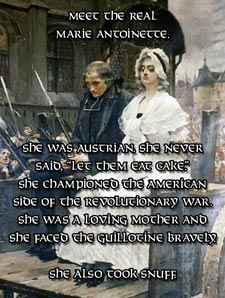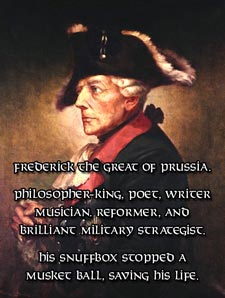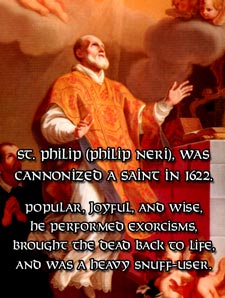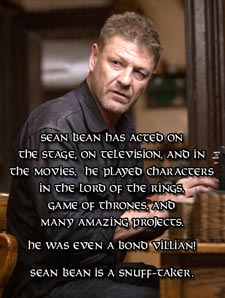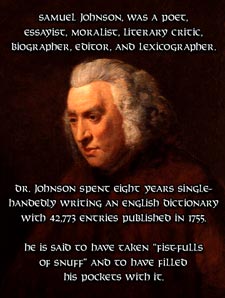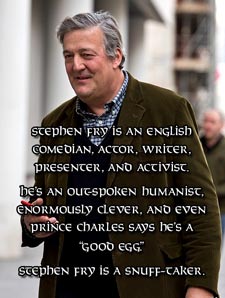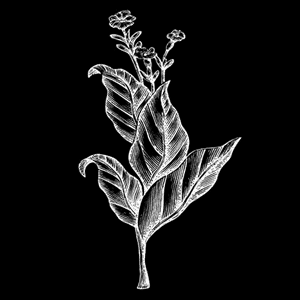
|
PAGES |
Famous Snuff-Takers By 1650, snuff use was common in Spain, France, England, Ireland, Scotland, throughout Europe, and in China, Japan, and Africa, and the American Colonies. Snuff taking was widespread and an integral part of social interaction. Kings, queens, clergy, future-saints, popes, generals, socialites, and other members of the upper-class used snuff. But snuff use was widespread among the working class as well. This is an partial list of famous snuff-takers, both then and now.
There is little doubt that many of the USA's Founding Fathers used snuff, as well as most known figures in history at the time. |
Snuff use was so common and universal for several centuries, that history texts rarely cover whether an historical figure used snuff or not, unless there is an interesting story surrounding their snuff use. Below we have included some interesting historical anecdotes regarding snuff tobacco....
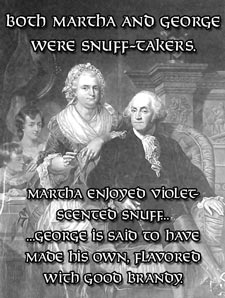 |
Click on the Images Above for Larger Versions
The items in Abraham Lincoln's pockets
the night of the assassination were as follows: a
pocketknife, a linen handkerchief, a sleeve button,
a fancy watch fob, two pairs of spectacles, a lens
polisher, a tiny pencil, tiny fragments of hard red
and green candy, a fine brownish powder
which appeared to be snuff, and a brown
leather wallet (one section was engraved "U.S.
Currency" and another section was engraved "Notes").
The wallet contained a Confederate five dollar bill,
and nine old newspaper clippings. Included among
these clippings were two articles of praise and five
others dealing with the issues that were on
Lincoln's mind during his final months.
This does not make it certain that Lincoln was a
snuff user, but it does raise interesting
questions.
Mozart's opera Don Giovanni is listed in the 1968 Guinness Book of Records as among the most rapidly written music committed to paper. Wine, snuff, coffee and his sixteen year-old chambermaid provided the necessary sustenance.
"I went to my writing table and sat there twelve hours on end, a small bottle of Tokay on my right, my inkstand in the middle and a box of Seville snuff on my left.,,, on the first day, between the Tokay, the Seville snuff, the coffee, the bell and my young muse, I wrote the first two scenes of Don Giovanni, two others of L'arbore di Diana, and more than half the first act of Tarar...."
Charles
Darwin used snuff as a stimulant while working. He
once game up snuff for a month, and described
himself as feeling "most lethargic, stupid, and
melancholy."
His moustache "slightly brown from the
habit" of using snuff, Charles Darwin
administered snuff to a monkey in order to
study its emotions. "It closed its eyelids whilst
sneezing; but not on a subsequent occasion whilst
uttering loud cries," he recorded.
Darwin's son wrote this about his father and his snuff-taking:
Our former neighbour and clergyman, Mr. Brodie Innes, tells me that at one time my father made a resolve not to take snuff except away from home, "a most satisfactory arrangement for me," he adds, "as I kept a box in my study to which there was access from the garden without summoning servants, and I had more frequently, than might have been otherwise the case, the privilege of a few minutes' conversation with my dear friend."
He generally took snuff from a jar on the hall table, because having to go this distance for a pinch was a slight check; the clink of the lid of the snuff jar was a very familiar sound. Sometimes when he was in the drawing-room, it would occur to him that the study fire must be burning low, and when some of us offered to see after it, it would turn out that he also wished to get a pinch of snuff.
Andrew Jackson used Snuff and he collected snuff boxes.
Actually Napoleon Bonaparte was known to have used 7 pounds or roughly 3 kg a month!! Thats 84 pounds or 38 kg a year.
King George III's wife Queen Charlotte, was referred to as 'Snuffy Charlotte', because she had an entire room at Windsor Castle devoted to her snuff stock.
King George IV, who had his own special blends and hoarded a stockpile of snuff.
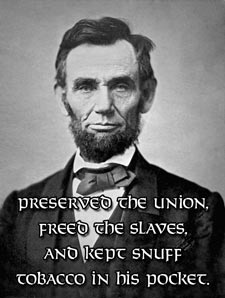 |
Click on the Images Above for Larger Versions
William F. Friedman was a
Cryptographer who worked on codes and
code-breaking during both World War I and
World War II, and starting in 1952 he
worked for the National Security Agency (NSA).
Before and during World War II he led the US Army's
Signals Intelligence Service (SIS). Friedman
was part of a small team that broke the
encryption on a Japanese cipher machine code-named
"Purple." Access to Japanese communication
encrypted with "Purple" allowed the USA to
intercerpt an order on December 7th,
1941 saying that "negotiations with the
USA had ended, and warning of impending war."
This decoded message was delivered to the State
Department hours before the attack on Pearl Harbor
that brought the USA into World War II.
William Friedman made other ground-breaking and
incredible accomplishments in the field of
Crytographology, but I found an interesting letter
among some personal documents released by the
NSA. In the documents was a letter from
Friedman to a woman named Mary Chambers asking her
to help him secure some fine English Snuff.
Apparently, while in London Friedman had
visited Fribourg and Treyer, and bought a snuff
called Morlaix. After returning to
Washington D.C. he had run out of his supply, and
was asking Ms. Chambers to assist in getting him
some more. In order to read William Friedman's
letter, simply Click Here.
Pope Benedict XIV was also a snuff-taker. He is said to have once offered his snuffbox to the head of some religious order, who declined to take a pinch of snuff, saying, "Your Holiness, I do not have that vice," to which the pope replied, "It is not a vice. If it were a vice you would have it."
Dr. Johnson, was an English writer who made lasting contributions to English literature as a poet, essayist, moralist, literary critic, biographer, editor and lexicographer. Johnson was a devout Anglican and committed Tory, and has been described as "arguably the most distinguished man of letters in English history." He is also the subject of "the most famous single biographical work in the whole of literature," James Boswell's Life of Samuel Johnson.
Samuel John spent eight-years compiling and writing his A Dictionary of the English Language, with 42,773 word entries, and approximately 114,000 literary quotations included to illustrate the usage and context of the words. Johnson had planned to complete the work in three years. In comparison, the Académie Française had forty scholars spending forty years to complete their dictionary of the French languate, which prompted Johnson to claim, "This is the proportion. Let me see; forty times forty is sixteen hundred. As three to sixteen hundred, so is the proportion of an Englishman to a Frenchman."
Johnson was a tall and robust man. His odd gestures and tics were disconcerting to some on first meeting him. Boswell's Life, along with other biographies, documented Johnson's behaviour and mannerisms in such detail that they have informed the posthumous diagnosis of Tourette syndrome, a condition not defined or diagnosed in the 18th century.
It is said that Dr. Johnson took snuff by the fistful and filled the pockets of his coats with the magic tobacco dust. Below is an image of one of his snuff-boxes. It is carved ivory in the shape of a gloved hand. It has a silver top that is engraved with, "Dr. Samuel Johnson, The Lexicographer, 1770, From a Friend." (Circa: 1770, Size: 4" H x 2 1/8" W x 1 3/4").
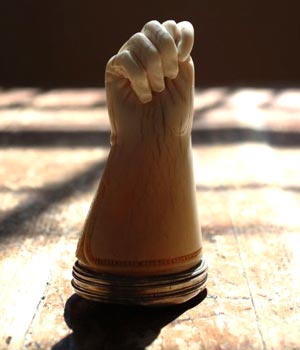
Pope Pius IX was an inveterate snuff-taker, and was so effusive and constant in it that he often had to change his long white soutane a few times a day-it was white, after all, and the snuff dust would settle on it. He offered snuff, and snuff-boxes to visitors. The Church had established a monopoly on the tobacco trade in the Papal States and, in 1863, during his pontificate, consolidated its tobacco processing operations under the Pontifical Director of Salt and Tobacco in a newly erected building on the Piazza Mastai in the Trastevere district in Rome.
When the representative of Victor Emmanuel came to him to submit conditions that the pontiff believed were unacceptable, the pope "beat on the table with a snuff box, which then broke." The representative "left so confused he appeared dizzy." In 1871, the pope also, during the time he was the "prisoner of the Vatican," offered up his "gold snuff-box, exquisitely carved with two symbolic lambs in the midst of flowers and foliage," to be offered as the prize in a worldwide lottery to raise money for the Church.
By the late 1700s, taking snuff nasally had fallen out of fashion in the United States. Instead, dry snuff users would use a twig as a brush to "dip" the snuff, which then involved placing the snuff inside the cheek. This is seen as a precursor to dipping tobacco (moist snuff) use which is still very much popular today. In addition, orally chewing tobacco or dipping snuff was more convenient for Americans trekking westward in their wagons.
Click on the Images Above for Larger Versions
In numerous articles about the rise of snuff's popularity in the 2000's, the actor Sean Bean is described as a well-known snuff aficionado. The following is from a Sean Bean interview from 1988:
Then he (Sean Bean) recited a favourite song – not least for his child – which he'd often chanted at Sheffield United games, to the tune of John Denver's Annie's Song."You fill up my senses, like a gallon of Magnet [bitter], like a packet of Woodbines, like a good pinch of snuff [from Wilson's Snuff Mill of Sheffield]; Like a night out in Sheffield, like a greasy chip butty…".
Pope Leo XIII favored snuff. Before he became pope, he had served for a time as papal nuncio in Brussels and enjoyed the conversation and company of the cultured and easy-going aristocrats there. One evening at dinner, a certain Count, who was a Freethinker, thought he would have a little fun at the nuncio's expense, and he handed him a snuff box to examine, which had on its cover a miniature painting of a beautiful nude Venus. "The men of the party watched the progress of the joke, and as for the Count he was choking with laughter, until the Nuncio deferentially returned the box with the remark: 'Very pretty, indeed, Count. I presume it is the portrait of the Countess?'" Toward the end of the pope's life, he suffered when he had to give up tobacco on the advice of his physicians.
A continuing tradition in the Senate chamber is the maintenance of two small snuffboxes, decorated with Japanese figures. In the early 19th century, a large snuff urn was kept in the Old Senate Chamber on the vice president's desk, and senators could help themselves freely to a pinch of snuff. During the tenure of Vice President Millard Fillmore, this snuff urn was replaced with the two Japanese snuff boxes. According to the Assistant Doorkeeper Isaac Bassett, the frequent interruptions caused by members approaching his desk for snuff so disturbed Fillmore that he asked Bassett to remove the urn. Bassett subsequently placed the two lacquered snuff boxes at opposite sides of the room. Today, these boxes are affixed to a ledge flanking the rostrum in the current Senate chamber. While the custom of taking snuff in the chamber has disappeared, the boxes still contain snuff, in keeping with this Senate tradition.
Venerable Marie Thérèse de Lamourous, having been shown the mantle of St. Teresa of Avila in the Carmelite convent in Paris, was allowed to put it on: "I kissed it; I pressed it upon me," she wrote, "I remarked everything, even the little stains, which seemed to be of Spanish snuff."
Charles III of Spain had a great predilection for rappee snuff, but only indulged his inclination by stealth, and particularly while shooting, when he imagined himself to be unnoticed.
During the beatification investigation of Philip Neri, to determine if he would be made a Saint, the man's snuff use became an issue. An examination of Philip Neri's corpse during the investigation showed that the soft tissues of his nose had gone and so his body was not incorruptible. It was suggested that this was due to his heavy use of snuff. Despite this set-back, Philip Neri was canonized a Saint in 1622.
The miracles attributed to St. Philip are interesting. During an exorcism he forced a demon dog out of a woman, and when it ran at him, he threw a mace at it causing it to flee. This was a man of action. Another time, a boy was drowning, and Philip "bi-located" right next to the boy in the water and drug him to shore. While praying, Philip was so filled with love that his heart expanded breaking two of his ribs! Another time, a young prince had died without making confession. Philip put holy water on the prince's lips, brought him back to life long enough to make his confession, and then let the boy slip away again.
Religious aspects aside, everything I read about Philip suggested he was a very good man at a time when good men were somewhat rare in the Catholic church hierarchy. I think snuff-takers can be proud this gentleman was one of us.
A few years before the constitutional convention in the United States, the King of France gave Benjamin Franklin a diamond encrusted snuff box after his diplomatic tour. Franklin did not appear to offer anything in return, but the gift nonetheless led to concerns that Franklin might be quietly corrupted by French interests-perhaps even without his knowing it.
The Americans, rigidly rejecting European custom, believed that acceptance of a luxurious gift by someone in power was itself a threat. Perhaps Franklin would be more generous toward French commercial interests simply by the operation of normal human sympathies, which to tend to be more charitable toward those who give us gifts. The framers tried to put a check on those sympathies, or at least put a block in the relationship, by requiring that Congress approve any gifts to federal officials.
St. John Vianney took snuff, often during his hours-long sessions hearing confessions.
Frederick the Great ruled Prussia from 1740 until his death in 1786. Frederick aspired to embody the Platonic ideal of a "philosopher-king." He was a poet, a writer, a musician, a domestic reformer and a brilliant military strategist.
Frederick led his nation through multiple wars with Austria and its allies. His daring military tactics expanded and consolidated Prussian lands, while his domestic policies transformed his kingdom into a modern state and formidable European power. He was an enthusiastic patron of the arts and sciences, and corresponded with the top minds of the Enlightenment. He had a long and sometimes contentious friendship with Voltaire.
Frederick The Great used snuff, especially under the stress of command. Once a musket balll hit a snuff box in his breast pocket, saving his life!
The cynical temper of Frederick the Great is well known. Once when his sister, the Duchess of Brunswick, was at Potsdam, Frederick made to the brave Count Schwerin the present of a gold snuff-box. On the lid inside was painted the head of an ass. Next day, when dining with the king, Schwerin, with some ostentation, put his snuff-box on the table. Wishing to turn the joke against Schwerin, the king called attention to the snuff-box. The Duchess took it up and opened it. Immediately she exclaimed,' What a striking likeness! In truth, brother, this is one of the best portraits I have ever seen of you.' Frederick, embarrassed, thought his sister was carrying the jest too far. She passed the box to her neighbor, who uttered similar expressions to her own. The box made the round of the table, and every one was fervently eloquent about the marvelous resemblance. The king was puzzled what to make of all this. When the box at last reached his hands, he saw, to his great surprise, that his portrait was really there. Count Schwerin had simply, with exceeding dispatch, employed an artist to remove the ass's head, and to paint the king's head instead. Frederick could not help laughing at the Count's clever trick, which was really the best rebuke of his own bad taste and want of proper and respectful feeling.
Padre Pio kept his snuff in a little pocket of his habit, and passed snuff around to his visitors. A biographer wrote that, "One evening, during a conference with oncologists, in the midst of a report on cancer research, Padre Pio turned to one of the men and asked, 'Do you smoke?' When the man replied in the affirmative, Pio, pointing his finger censoriously, chided, 'That's very bad,' then, with almost the same breath, turned to another doctor and asked, 'Have you got any snuff?'" Saint Pio of Pietrelcino died in 1968, and was canonized a Saint in 2002.
In 1712 the Duke de Noailles presented the Dauphiness of France with a box of Spanish snuff in which she delighted ; she kept it for a few days privately; it was charged with poison, which she inhaled ; and five days after the present, died of it, complaining of sharp pain in the temples. This excited much attention, and great fears of " accepting a pinch," on the one hand, or offering it on the other. It became a general belief that such poisoned snufi' was used in Spain, and by Spanish emissaries to clear away political opponents', and that the Jesuits also adopted it for the purpose of poisoning their enemies. Hence it was termed " Jesuits' snuff," and agreat dread of it was felt for a considerable time.
"One of the grandest figures
that ever frequented Eastern Yorkshire was William
Smith, the distinguished Father of English Geology. My
boyish reminiscence of the old engineer, as he
sketched a triangle on the flags of our yard, and
taught me how to measure it, is very vivid. The drab
knee-breeches and grey worsted stockings, the deep
waistcoat, with its pockets well furnished with
snuff-of which ample quantities continually
disappeared within the finely chiselled nostril-and
the dark coat with its rounded outline and somewhat
quakerish cut, are all clearly present to my memory."
From "Reminiscences of a Yorkshire Naturalist" (1896) by William Crawford Williamson
In the 18th century giving a snuff box as a present became a sign of exalted gift-giving. Marie Antoinette had fifty-two gold snuff boxes in her wedding basket. While this may seem extravagant, it should be remembered that in the eighteenth century the snuff box was the equivalent of jewellery and not only did the snuff box change with artistic fashion but anyone who was anyone needed to have a variety of these boxes.
What most people think they know about
Marie Antoinette is actually false. She was originally Austrian. She never
actually said, "Let them eat cake." She was a
champion of the American side of the Revolutionary
War, and without her efforts the war might have
ended quite differently. After the French
Revolution, none other than the American
revolutionary Thomas Paine (at that time part
of the French Legistlature, as strange as that
sounds) advocated exile for the Royal Family to
the United States, rather than death.
Marie Antoinette was a loving dedicated
mother, and she faced execution
by guillotine bravely. Marie Antoinette
also took snuff, though it is said she was more
likely to carry a box of bon bons on her person,
than a snuff box.
She may have also standarized the modern
handkerchief as we think of it today. The
handkerchief has a long history as a piece of cloth
carried to clean one's nose. But, prior
to the triumphant arrival of
tobacco (specifically snuff tobacco) in Europe,
the handkerchief had become an object of
fashion. Snuff brought the handkerchief back
to its original purpose, as it became indispensable
for cleaning snuff-stained noses! White
handkerchiefs were hardly suitable for this and
people took to using large, coloured kerchiefs to
hide the stains. Up until this time, the
handkerchief had come in many shapes, such as round,
square, triangular, etc. According to legend, one day Marie
Antoinette at Versailles remarked that the
square-shaped handkerchief was the most pleasing as
well as convenient. This prompted Louis XVI to make
it mandatory for all handkerchiefs produced within
the kingdom to be square in shape. And
the rest, as they say, is history.
There is a lot of interesting history surrounding tobacco snuff. If you know of other famous snuff-takers or interesting historical anecdotes, please feel free to share them with us for inclusion on this page.
Send comments to markstinson@onmail.com. Don't forget to visit our Blog and Facebook Group.
Modern Snuff © 2015, 2016, 2023 by Mark Stinson


